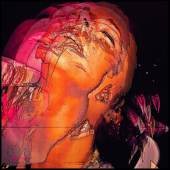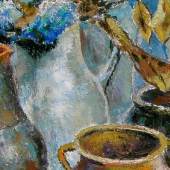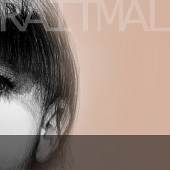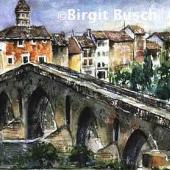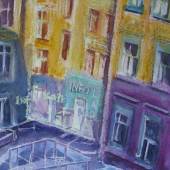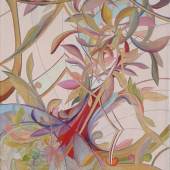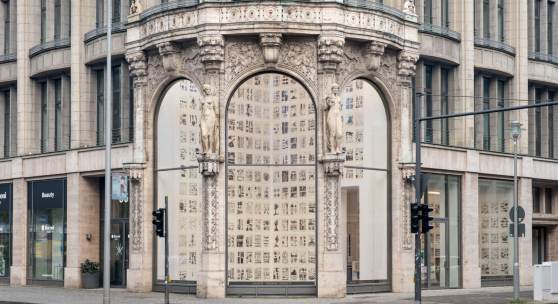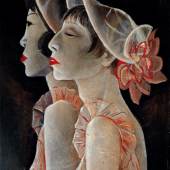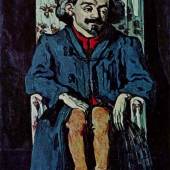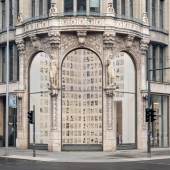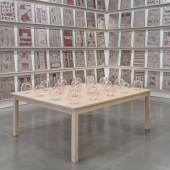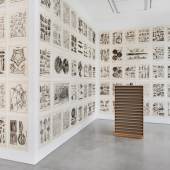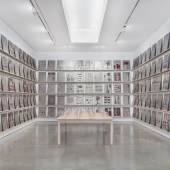Galerie Schulte
MATT MULLICAN NEW EDINBURGH ENCYCLOPEDIA, 1825
-
Ausstellung27.04.2024 - 15.06.2024
Galerie Thomas Schulte presents a solo exhibition of installations along with editions by Matt Mullican on the occasion of this year’s Gallery Weekend Berlin. In rows of assembled images and objects in metal, paper and glass, New Edinburgh Encyclopedia, 1825 foregrounds the artist’s long-established encyclopedic approach and engagement with systems of knowledge, order and representation. While the works on view—produced in the 1990s—draw on an encyclopedia dating back nearly 200 years, they also point to the ways—virtual and real, in which we attempt to categorize, contain, and make sense of the world at present.
The work referred to in the exhibition title consists of two parts, which each in turn contain multiple components: 449 magnesium relief plates that carry the contents of the titular book, and the rubbings on paper that were made from them. Rarely shown together, the physical transfer and reproduction of images and information is enacted through their proximity and across different spaces of the gallery. The metal plates become a sort of origin—the source from which reproductions can continuously be made. Propped up on narrow shelves, grid-like, in long, parallel rows that weave alphabetically up and down, an organizing principle is introduced. Through it, illustrations, plans, and diagrams on topics in engineering, architecture, anatomy, and horticulture, among other practical knowledge, can be found. In what might call to mind a science museum or library display, the framework offered by this historical reference book gives structure to and constitutes the space—bringing into consideration the role and purpose of an encyclopedic model in shaping our reality.
In the gallery’s front Corner and adjacent window spaces are the rubbings produced from the plates using paint stick on paper—at once prints, drawings, and paintings. Mullican refers to rubbing as the first medium for making reproductions, situating these works within a long history of transferring and sharing images, text and data. The representations that result from this process are faithful copies of a sort, but also something else: translations of marks from one object or material to another.
In Untitled (20 glass balls), displayed alongside the metal plates in a similar grid system, cataloging of another kind has taken place. The artist’s own reference system, his cosmology, is mapped in red marker onto balls arranged in rows on a wooden table. Mullican’s cosmology (of which there are two) is at the core of his practice, coming to form in pictograms, city maps and charts in a wide range of media, materials, and scales. The first cosmology he developed deals with fundamental questions about the nature of existence from before birth to after death, while the second consists of five worlds; different levels of perception, each associated with different symbols and colors: red corresponds to the world of the subjective, black to the world of symbols and language, yellow to the “framed” world—culture, art and the now—blue to the “unframed” everyday world, and green to the material world. Similarly encyclopedic, it is an attempt to break down and understand the world that appears to be objective, using familiar everyday elements of a chart or map, while offering a highly personal view—hand drawn and cryptic.
Circular forms and spheres, basic geometric shapes, feature frequently in Mullican’s work, and, of course, make a wider historical reference to cosmological illustrations and models more broadly. As balls made of transparent glass, form is given to space even as the closed circle takes on an apparent openness, through which the division between inside and outside becomes less distinct and the hierarchy of the chart is put into question. The artist’s cosmology and real space bleed into one another, as correspondences build between the round objects and the numerous circular illustrations inscribed on the metal plates. Less anchored and more abstract than the durable metal images, the glass objects also display a certain fragility, an illusory quality. Almost like a crystal ball, they might be seen as a symbol of the search for meaning and answers to existential questions; as what emerges from them remains open to different readings.
Bringing these works together under the scope of New Edinburgh Encyclopedia, 1825 puts forth an origin and continuity of images centuries in the making—from their reproductions and transformations, to the frameworks they create—while allowing space for alternative models. The exhibition offers a focused yet expansive view of a decades-spanning practice that continues to reflect the simultaneous drive toward and sheer impossibility of comprehending and representing life, the world—subjective or universal—in its entirety.
Text by Julianne Cordray
- << Le Panier de fraises
- zurück | vor
- IDEA sei Dank >>
-
23.01.2022 - 31.12.2024Berlin ist permanent im Wandel. Auch die Kunstszene der Stadt erfindet sich immer wieder neu....
-
15.09.2022 - 18.09.2022Die POSITIONS Berlin Art Fair freut sich, ihre neunte Ausgabe anzukündigen. Vom 15. – 18....
-
31.05.2024Ernst Ludwig Kirchners meisterhaftes Gemälde „Heuernte“ von 1924-26 veranschaulicht...
-
Die Neue Nationalgalerie, der "lichte Tempel aus Glas", beherbergt europäische Malerei...
-
Wo Sie die Werke Cézannes besichtigen können: National Gallery, London „Alte...
-
27.04.2024 - 15.06.2024
Montag geschlossen
Dienstag von 12.00 Uhr bis 18.00 Uhr Uhr
Mittwoch von 12.00 Uhr bis 18.00 Uhr Uhr
Donnerstag von 12.00 Uhr bis 18.00 Uhr Uhr
Freitag von 12.00 Uhr bis 18.00 Uhr Uhr
Samstag von 12.00 Uhr bis 18.00 Uhr Uhr
Sonntag geschlossen
